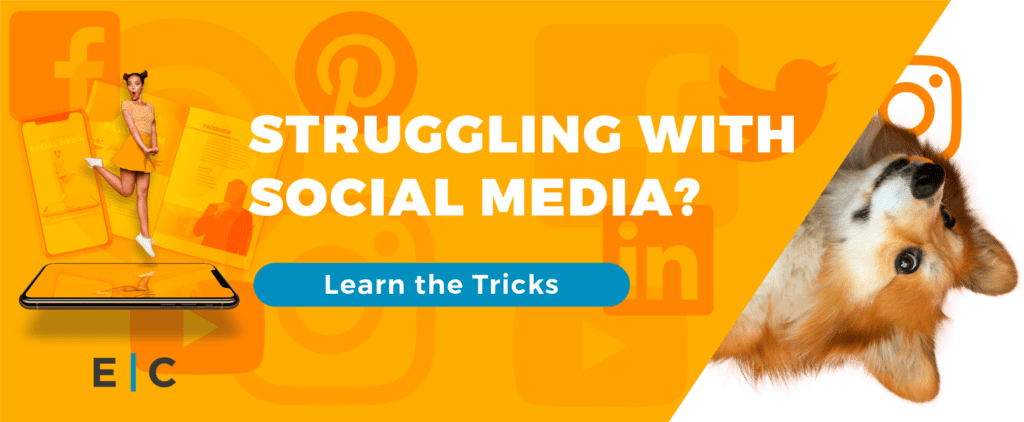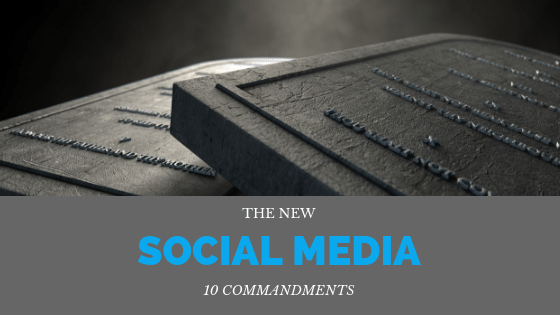Facebook is DEAD! Twitter is DEAD! Instagram is DEAD! Snapchat is DEAD! If you’ve read any social media news in the past few months, each of the platforms has been declared dead at least once. While this type of clickbait is often, at best, a poor attempt at provocation, it does bring to light an overall truth: Social Media has changed.
Millennials and Generation Z have quickly and efficiently been evolving our digital landscape and platforms are scrambling to keep up. As businesses and marketers, it’s important for us to stay current AND look ahead to make sure what we’re doing and saying don’t alienate us from the very people we want to attract.
With this in mind, I’m declaring a new list of best practices you need to keep in mind when putting together your social media strategies.
Social Media Commandments for Today and Tomorrow
-
- Post consistently. This isn’t a new or revolutionary idea AND YET the number of times we review and analyze pages that post inconsistently is staggering enough that I need to put this as the first thing on this list.
Goal: You don’t have to post every day. Pick a schedule that makes sense for you and your followers and stick to it.Here’s an example posting schedule:
Facebook: 1x a day, M-Su
LinkedIn: 1x a day, M-F
Instagram: 3x a week
Twitter: Twitter is the outlier here. If you can’t be super active on Twitter (10-24 posts a day), then it may be something you want to leave off out of your consistent messaging strategy. I advise clients who can’t dedicate the time to it to think more about purchasing sponsored tweets on larger, established accounts to get your message out.AND REMEMBER: social algorithms, like Facebook’s latest update, are more worried about engagement rates, not the frequency of posts. Think quality over quantity. - Have a diverse content mix. Don’t.just.post.your.blogs. Ok? Please. Share your content, of course, but share other people’s content, share videos, share GIFs, and infographics, and images. Your users don’t only want to know what you’re doing—they want to know how your brand improves their lives. Information you can share with them—even from other sources—helps you become a brand that is part of their life.
Goal: Create a content calendar/write some posts in advance so you can really see how it looks overall instead of just posting day to day. Think of the type of content you want to share and some themes that work with your business.Here’s an example content schedule for Facebook:
Monday: Native content piece (example: a blog about digital marketing trends)
Tuesday: Curated piece (example: a WordStream article about PPC)
Wednesday: Digital marketing meme
Thursday: Native CTA about your digital marketing service
Friday: A poll about the digital marketing services that people need the most
Saturday: A Spotify playlist to help keep people productive
Sunday: An inspirational post to get users ready to hit the ground running come Monday.
In 7 days this schedule has native and curated content, a meme, a CTA (lead generation!), an interactive poll, music, and a compelling, shareable image. You don’t have to repeat this every week but it’s easier for your users to follow the thread and be engaged if you provide them with a path to take!
- Get video on your list. I truly cannot emphasize this enough. VIDEO IS KEY! In fact, Cisco said that, by 2020, 85% of US internet traffic will be for video. HELLO. WHAT?!? That’s a lot of videos. Gen Z-ers already watch up to 68 videos A DAY. Long story short: get.video.on.your.list.
Goal: You don’t need to be a documentarian to create video content for social. You just need a decent camera (iPhone, Android, or GoPro if you’re fancy) and take some little boomerangs (it’s an app) or a short, education video about a product or service. Get creative!
- Automate what you can. Posting on social? Ain’t nobody got time for that. But you should, and you have to. SO, what is a busy person to do (besides hiring a certain agency with an excellent track record of providing social services and inbound marketing)? Automate. There are plenty of tools that enable you to create content and schedule it ahead of time, so you can load up your social pages with messaging and let it run in the background while you do your thing.
Goal: Invest in a social scheduling tool. We don’t have a particular partner we work with, so you can look into Buffer, Hootsuite, Sprinklr, Percolate, Edgar, Oktopost—there are a lot. If you use an automation toolset like HubSpot or Sharp Spring, you may already have social scheduling and reporting tools on hand that you’re not using! Check it out and see what works for you.
- Engage with your community. People expect a faster response through social than they do on the phone. Comments, messages, reviews, and likes are all ways people can reach out and interact with your brand any second of any day. It’s important that you exercise your customer service and care by responding to comments, reviews, and messages as quickly as you can.
Goal: Make time daily to check your social pages to make sure you’re not missing out on important questions, messages, etc. If you don’t have the time, find someone on your team who does. You can’t afford to let a few days go by without checking your social page. Facebook, in particular, cares about how quickly you respond to your direct messages and will give you a badge on your page if you respond quickly.
Side note: Consider implementing chatbots to answer simple, frequently asked questions. There are SO MANY tools on the market, you can find something that makes sense for you—and they never sleep, so there’s always someone (or something) there to answer questions.
- Fill out your profiles! Like #1, this is not an earth-shattering, disruptive suggestion. BUT, like #1, we see it more often than not: an incomplete profile, missing information, and even (gasp) typos. Be sure to go through your social profiles and fill out ALL of the information. The point is to give your fans, followers, and visitors all the information they need. They’re not all going to go to your website to look around for more info, so be sure you’re representing yourself completely wherever you can.
Goal: if you’re strapped for time, take an hour a week for the next four to see weeks and check one of your platforms. Be sure the information is complete, up to date, and accurate.
- Post consistently. This isn’t a new or revolutionary idea AND YET the number of times we review and analyze pages that post inconsistently is staggering enough that I need to put this as the first thing on this list.
- YouTube counts. YouTube is considered social media. Repeat this as many times as you need in order for it to sink in and become cannon. Millennials and Generation Z love YouTube and interact with it a shocking number of hours a day. In fact, YouTube has just unseated Facebook as THE NUMBER ONE SOCIAL MEDIA PLATFORM for Gen Zers. I mentioned video content earlier in this list as an important part of your social strategy, YouTube plays a large part in this as well.Goal: You probably don’t have the amount of video content needed to start a solid YouTube channel right now, and that’s OK. Just start making video content a consistent part of your strategy and, over time, you’ll start building up enough content to make YouTube a real part of your social presence.
- Don’t be on it just to be on it. Back in the day, it was BE EVERYWHERE AT ALL TIMES but businesses and, most importantly, users realized that this all or nothing approach didn’t work. With ALL of the platforms that currently exist it’s impossible for you to be everything to all people and do it well. Pick 2-3 platforms you can really own and focus on those.
Goal: Take a look at your audience and see who they are and where they live online. Take a look at your referral traffic channels for social. Are Facebook and LinkedIn your top 2 performers? Cool! Make sure your strategy really focuses on that. If Twitter and Pinterest barely move the needle—cut them. Make sure you are serving great content to people who want to see it!
- Copy edit. This is a no-brainer…you’d think. But the number of typos, weird phrasing, and terrible hashtag uses we’re confronted with on a daily basis serve as the saddest of reminders that attention to detail and copy editing are not a part of everyone’s social media process. Make sure there is someone reading over the messaging that is NOT the person who wrote it. Writers get fatigued, we look at something SO many times we don’t even see it anymore.
Goal: Have fresh eyes do a last look on your content just to make sure everything is ready to publish! - Have a voice. On social media, companies are people. Users expect personalities on social and that applies to businesses, as well. Think about your fans and followers, your user personas, your target audience—who are they and what do they care about? Are they more conservative? Quirkier? Do they like videos and gifs or do they prefer articles and checklists? Think about the words they use and the words they wouldn’t use and start to build your social voice around that. Remember that you have a little more leeway on social than you do on your website. Where websites have to veer more toward mass appeal, your social media presence can be fun, quirky, and original. Just make sure it makes sense for your brand!
Goal: Take a look at the social of your competitors. Do you all sound the same? Take a look at your own social. Are your posts getting engagement from your followers? Do people like your posts? Do some research and make sure the voice in which you’re writing your social posts is one that makes sense and resonates with your fans and followers.
You did it! You made it all the way to the end of the new Social Media Commandments! I don’t have a sticker or a badge to give you but know that I’m sending you the rad-est of mental high fives.
Still have burning questions? Need more help with your social than what this post provides? Reach out to us for a consultation and see how we can help!

-FINAL(01-00)-White&Blue-01.svg)




